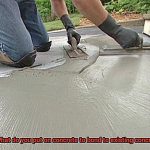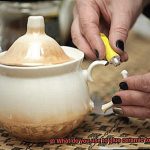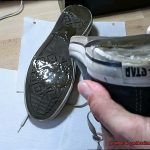Mortar, the unsung hero of construction, is the magical paste that binds bricks and masonry units together. It’s the secret ingredient that gives strength and stability to buildings, ensuring they stand tall against the test of time. But what exactly is mortar and how does it work?
At its core, mortar is a simple mixture of three key components: cement, sand, and water. Cement acts as the glue, holding everything together with its binding properties. Sand adds bulk to the mixture and fills in the gaps between the bricks. Water, the catalyst, activates the cement and transforms the dry ingredients into a workable paste.
The process begins with thorough mixing of the cement and sand, creating a harmonious blend. The ratio of cement to sand can be adjusted depending on the desired strength and consistency of the mortar. Once mixed, water is added gradually while continuously stirring until a smooth, uniform paste is achieved. Speed is crucial here; adding water too quickly can make the mixture runny, weakening its bond.
Now comes the fun part – applying the mortar to the surface of the bricks. Armed with a trusty trowel or pointing tool, the mortar is spread evenly across the bricks, filling in every nook and cranny. Excess mortar is scraped off with finesse, leaving behind a clean and polished finish.
But we’re not done yet – patience is key. As time passes, a chemical reaction called hydration takes place within the mortar. This causes the cement to harden, forming an unbreakable bond between each brick. It typically takes several days for this process to complete, during which it’s crucial to protect the mortar from excessive moisture or extreme temperatures that could hinder its proper curing.
One of mortar’s remarkable qualities is its ability to accommodate slight movement between bricks without cracking or crumbling. This flexibility allows for natural expansion and contraction caused by temperature changes or settling of the structure over time. Additionally, mortar provides insulation and soundproofing, enhancing the overall performance of the building.
Advantages of Using Construction Adhesive
Contents
- 1 Advantages of Using Construction Adhesive
- 2 Specialized Brick Adhesives: Different Forms and Applications
- 3 Benefits of Metal Connectors and Reinforcements
- 4 Factors to Consider When Selecting Materials or Techniques for Joining Bricks
- 5 Choosing the Right Material or Technique for Your Project
- 6 Professional Advice on Joining Bricks Together
- 7 Conclusion
Using construction adhesive to join two bricks together offers numerous advantages. Here are some of the key benefits:
- Strong Bond: Construction adhesives are formulated to provide exceptional bonding strength. They create a strong and durable bond between the bricks, ensuring that they remain firmly attached to each other. This is particularly important in structural applications where the integrity and stability of the construction are crucial.
- Versatility: Construction adhesives offer a high level of versatility. They can be used for bonding different types of materials, including bricks, concrete, wood, metal, and more. This versatility makes construction adhesive a go-to option for professionals and DIY enthusiasts alike, as it eliminates the need for multiple types of adhesives for different materials.
- Ease of Application: Another advantage of using construction adhesive is its ease of application. Unlike traditional methods such as mortar or cement, which require skilled labor and precision during application, construction adhesive can be applied easily by anyone with minimal training. It comes in convenient tubes or cartridges, allowing for precise and controlled application without any mess or extensive preparation.
- Quick Cure Time: Construction adhesives have relatively quick cure times compared to other bonding methods. Once applied, the adhesive starts to cure and form a strong bond within a short period. This allows for faster project completion and reduces downtime, making it an ideal choice for time-sensitive construction projects.
- Water and Weather Resistance: Many construction adhesives are formulated to be water and weather-resistant, providing added protection against moisture, humidity, temperature fluctuations, and harsh environmental conditions. This makes them suitable for both interior and exterior applications, ensuring long-lasting durability and preventing the bond from weakening over time.
- Increased Structural Integrity: When bricks are joined using construction adhesive, the bond created enhances the overall structural integrity of the construction. The adhesive spreads evenly over the contact surface, filling any gaps or irregularities between the bricks. This results in a more stable and solid connection, reducing the risk of movement or separation of the bricks over time.
- Flexibility: Construction adhesives offer a certain degree of flexibility, allowing for slight movements or vibrations without compromising the bond. This is particularly beneficial in situations where there may be minor shifts or settling in the building’s foundation. The flexibility of construction adhesive helps to absorb these movements, preventing cracks or detachment of the bricks.
- Cost-Effective: In comparison to traditional methods, such as mortar or cement, construction adhesive is often a more cost-effective option. The ease of application, reduced labor requirements, and faster curing times contribute to overall cost savings. Additionally, construction adhesive eliminates the need for specialized tools and equipment, further reducing expenses.
Specialized Brick Adhesives: Different Forms and Applications
Specialized brick adhesives come in various forms, providing unique properties and applications. Mortar, a mixture of cement, sand, and water, is commonly used in masonry construction for both load-bearing and non-load-bearing applications. It offers a strong and durable bond that has stood the test of time.
Epoxy resin is another specialized adhesive that consists of a resin and a hardener. When combined, it creates a robust bond capable of withstanding heavy loads and extreme weather conditions. This adhesive is ideal for high-strength and durable applications like bridge construction.
Polyurethane-based adhesives are known for their flexibility and resistance to moisture. They provide a strong bond that can handle movement and vibration, making them suitable for both indoor and outdoor projects.
Silicone-based adhesives are chosen for their resistance to moisture and temperature extremes. They offer a flexible bond that can accommodate environmental stressors, making them ideal for interior and exterior applications.
Additionally, there are other options available such as acrylic-based adhesives or hybrid adhesives that combine the properties of different adhesive types. The choice of adhesive depends on factors like the specific application, desired bond strength, and environmental conditions.
Proper surface preparation, including cleaning and roughening the brick surfaces, is crucial for achieving a strong bond. Following the manufacturer’s instructions regarding mixing ratios, curing times, and application techniques is also important.
Benefits of Metal Connectors and Reinforcements
Metal connectors and reinforcements have numerous benefits that make them an ideal choice for joining and strengthening masonry structures. Their strength and durability set them apart from other adhesive methods, ensuring a secure and long-lasting connection between bricks. These connectors can withstand heavy loads, vibrations, and external forces, guaranteeing the stability and integrity of the structure.
In addition to their strength, metal connectors offer flexibility in design. They come in various shapes and sizes, allowing for customization according to the specific needs of the building project. This versatility enables architects and builders to create complex structures while maintaining structural integrity.
Metal connectors also provide resistance to fire and moisture. Unlike organic adhesives that can degrade or lose effectiveness when exposed to extreme temperatures or water, metal connectors remain unaffected. This makes them suitable for both indoor and outdoor applications, as well as in areas prone to high humidity or fire hazards.
Furthermore, metal connectors contribute to cost savings in the long run. Although they may be more expensive upfront compared to adhesive methods, their durability and low maintenance requirements make them a cost-effective choice over time. They eliminate the need for regular inspections, repairs, or replacements that may be necessary with weaker connections.
Another advantage of using metal connectors is their ability to enhance structural stability. By providing a rigid connection between bricks, they help distribute loads evenly across the structure. This prevents concentrated stress points and reduces the risk of cracks or failures. The added stability improves overall safety and longevity of the building.
Lastly, metal connectors are environmentally friendly compared to certain adhesive methods that contain volatile organic compounds (VOCs). These compounds can be harmful to human health and the environment. Metal connectors do not release VOCs, making them a safer and more sustainable choice for construction projects.
Factors to Consider When Selecting Materials or Techniques for Joining Bricks
- Strength and Durability: The joint should be able to withstand load and stresses without compromising the structural integrity of the bricks. Consider weather conditions, moisture exposure, and weight-bearing capacity.
- Compatibility: Different types of bricks require different joining methods. Ensure that the selected material or technique is suitable for the specific type of bricks being used to achieve a strong and long-lasting bond.
- Ease of Application: Some methods may require specialized skills, tools, or equipment, while others are more user-friendly. Consider the skill level and resources available to successfully implement the chosen method.
- Cost: Evaluate the budgetary constraints before making a decision. Balance cost-effectiveness with quality to select materials or techniques that align with the project’s financial requirements.
- Aesthetic Appeal: Consider the overall design and architectural style of the project. Different materials or techniques can create different appearances, so select a method that aligns with the desired aesthetic outcome.
Choosing the Right Material or Technique for Your Project
Choosing the right material or technique for your project is crucial when it comes to joining bricks together. Whether you’re working on a small DIY project or a large-scale construction, considering the following factors will help you make an informed decision:
Project Requirements:
- Determine the purpose of the structure and its load-bearing capacity. Will it be a wall, a foundation, or something else?
- Consider weather conditions, exposure to moisture, and potential seismic activity. This will help you choose materials that can withstand these conditions.
- Evaluate the desired aesthetics and architectural style. Different materials and techniques can create different visual effects.
Material Options:
Mortar:
- Cement mortar: The most common type of mortar used for bricklaying, providing excellent durability and stability.
- Lime mortar: Suitable for historic or restoration projects, as it allows for movement and flexibility.
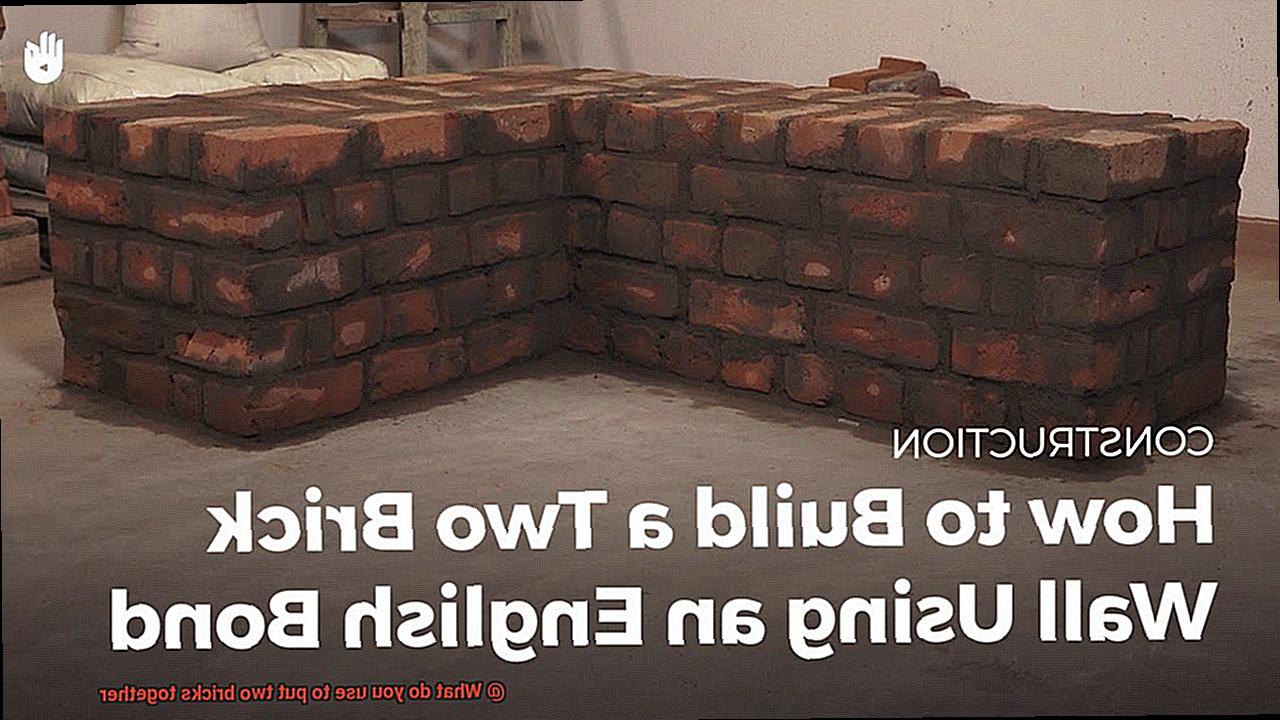
Adhesives or Glues:
- Masonry adhesives: Specifically designed for masonry applications, providing a strong bond between bricks without traditional mortar.
- Check for compatibility with the specific type of bricks being used.
Mechanical Methods:
- Metal connectors: Brick ties or anchor bolts embedded into mortar joints to provide additional strength and structural integrity.
- Suitable for areas prone to seismic activity or when a higher level of strength is required.
Considerations for Glue as an Option:
- Look for adhesives specifically designed for masonry applications. They are formulated to provide strong and durable bonds between bricks.
- Ensure compatibility with the specific type of bricks being used. Some adhesives work better with certain brick materials.
- Choose from various adhesive options available in cartridges for easy application using a caulking gun.
- Assess the strength and durability of the adhesive to meet project requirements.
Additional Factors to Consider:
- Cost-effectiveness: Evaluate the budget constraints and find a balance between affordability and quality.
- Ease of Application: Consider your skill level and available resources when selecting a material or technique.
- Follow proper installation techniques and guidelines provided by manufacturers to ensure the best results.
Professional Advice on Joining Bricks Together
The strength and durability of any structure depend on the proper bonding of bricks. Joining bricks together is a critical aspect of construction projects. While traditional methods like mortar have been widely used, modern alternatives such as construction adhesives offer several advantages.

In this section, we will discuss the importance of preparing brick surfaces before applying construction adhesive, the types of adhesives used for this task, and provide step-by-step instructions for achieving a successful bond.
Types of Construction Adhesives:
There are several types of construction adhesives available for joining bricks. Epoxy-based adhesives are known for their high strength and durability, making them suitable for heavy-duty applications. They can withstand heavy loads and provide excellent resistance to chemicals and impacts. Polyurethane adhesives offer excellent flexibility and resistance to moisture, making them ideal for outdoor projects where weathering is a concern.
Silicone-based adhesives provide superior weathering resistance and are commonly used for sealing and bonding bricks in areas exposed to extreme temperature variations.
Advantages of Construction Adhesives:
Construction adhesives offer numerous benefits over traditional methods like mortar. They provide a strong bond between bricks, eliminating the need for mixing mortar and reducing installation time significantly. Adhesives also have high resistance to moisture and weathering, ensuring long-term durability. Furthermore, they can bond different types of bricks together, allowing for greater design flexibility.
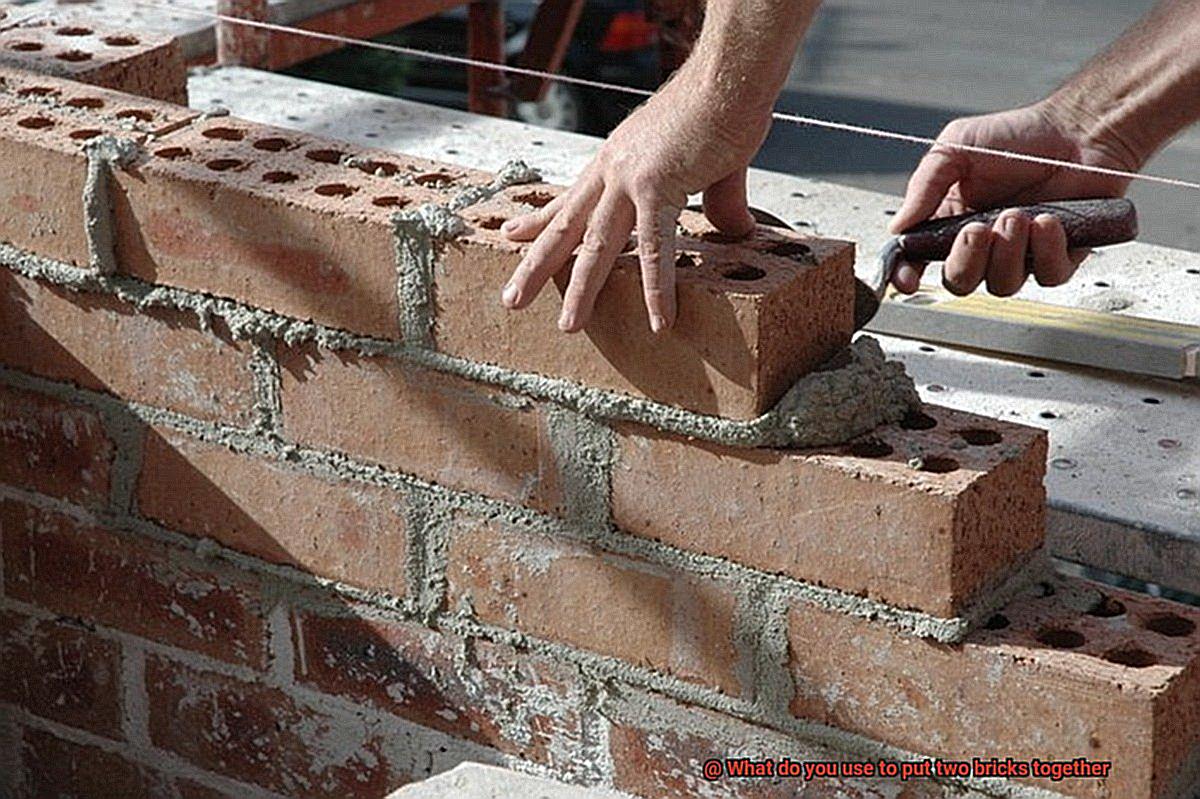
Surface Preparation:
Properly preparing brick surfaces is crucial for achieving a strong bond with construction adhesive. Start by cleaning off any dirt, dust, or loose particles from the brick surface using a wire brush or compressed air. This ensures that the adhesive can adhere properly to the surface.
Some adhesives may require roughening the surface with sandpaper or applying a primer for better adhesion. Always refer to the manufacturer’s instructions for specific surface preparation requirements.
Application Process:
When applying construction adhesive, it is important to apply an even layer on the brick surface. Use a notched trowel or a caulk gun to ensure consistent coverage. Apply the adhesive in a zigzag pattern or parallel lines to ensure maximum contact with the brick surface.
Align the bricks as desired and press them firmly together to create a strong bond. Be mindful of any specific curing time mentioned by the adhesive manufacturer to allow the adhesive to set properly.
Safety Considerations:
When working with construction adhesives, it is important to follow safety guidelines. Ensure proper ventilation in enclosed spaces to avoid inhaling fumes. Some adhesives may contain volatile organic compounds (VOCs), so it is essential to work in well-ventilated areas or use respiratory protection if necessary. Wear protective gloves and eyewear to protect your skin and eyes from the adhesive. Keep adhesives out of reach of children and pets. Always read and follow the manufacturer’s instructions for the specific adhesive being used.
Additional Tips:
Consider factors such as project requirements, environmental conditions, and the expertise needed for complex projects. Choose the right adhesive based on these factors and consult with professionals if necessary. It is also recommended to test the adhesive on a small area before applying it to the entire surface to ensure compatibility and performance.
91aKz0_thRM” >
Conclusion
In conclusion, there are several options available for joining bricks together. The most common method is using mortar, a powerful combination of cement, sand, and water. Mortar not only provides strength and stability to buildings but also allows for natural expansion and contraction, ensuring long-lasting structures.
However, construction adhesives have gained popularity due to their numerous advantages. These adhesives offer a robust bond between bricks and bring versatility in application. They are incredibly easy to use and cure quickly, saving valuable time during construction projects. Additionally, they provide excellent resistance to water and weather conditions, ensuring the longevity of the structure. Moreover, construction adhesives enhance structural integrity by accommodating movement and flexing with the building.
When it comes to construction adhesives, there are different types available depending on your project’s specific requirements. Epoxy-based adhesives are perfect for heavy-duty applications as they provide unmatched strength and durability. On the other hand, polyurethane adhesives offer flexibility and moisture resistance, making them ideal for areas prone to dampness. If extreme temperature variations are a concern, silicone-based adhesives provide exceptional weathering resistance.
To achieve a strong bond with construction adhesive, proper surface preparation is crucial. It is essential to meticulously clean off dirt and loose particles from the brick surface before applying the adhesive. This ensures optimal adherence and maximizes the bond’s strength.
When working with construction adhesive, always follow the manufacturer’s instructions regarding curing times and application techniques. Safety precautions should be taken seriously when handling these powerful bonding agents.
Choosing the right material or technique for joining bricks depends on various factors such as strength requirements, compatibility with brick type, ease of application, cost-effectiveness, aesthetic appeal, and environmental considerations. It is always wise to consult professionals who can provide valuable advice tailored to your specific project needs.
Ultimately, whether you choose mortar or construction adhesive depends on your unique preferences and requirements.


